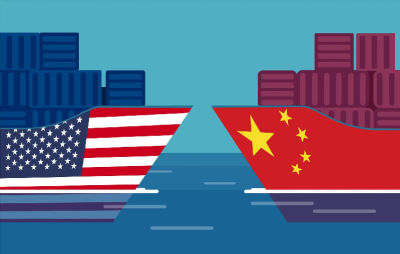China’s Turn
BRICS, 6 Mar 2023
Mike Whitney | The Unz Review – TRANSCEND Media Service
1 Mar 2023 – The U.S. Hyper-Financialized Economic System Is No Match for China’s Government-Directed Investment Model–Regrettably, China’s Explosive Growth Is Pushing a Desperate Washington Closer to War
Ukraine is the first flashpoint in a great power struggle between the United States and China. After years of shifting its industries to low-wage locations around the world, the US finds itself steadliy losing market-share to a faster-growing and more resourceful China. By most estimates, China’s economy will overtake the United States by 2035 at which point, Beijing will be in a much better position to shape international trade relations in a way that promotes its own interests. With growth, comes power, and that rule will certainly apply to China as well. China has emerged as an industrial powerhouse that sits at the very epicenter of the most populous and fastest growing region in the world. It is for that reason that the United States has initiated a series of provocations on the island of Taiwan and in the South China Sea. The US has abandoned all hope of prevailing over China through conventional free market competition. Instead, the US plans to engage China militarily in a desperate attempt to drain its resources, garner broader support for economic sanctions and isolate isolate China from its regional trading partners. It is a risky and disruptive plan that could backfire spectacularly, but Washington is moving forward regardless. US foreign policy mandarins and their globalist allies will not accept an outcome in which China is the world’s biggest and most powerful economy. This is from an article at China Macro Economy:
Although the pace of China’s economic rise has slowed in recent years, it appears on track to end the United States’ lengthy run as the world’s largest economy by around 2035, according to the latest projection by economists at Goldman Sachs.
The new estimate is 10 years later than the investment bank had predicted in 2011. But economists Kevin Daly and Tadas Gedminas said that potential growth in China still remains significantly higher than in the US.
“China has already closed most of the gap with US GDP,” they said in a report published on Tuesday, adding that China’s gross domestic product has risen from 12 per cent of the US’ in 2000 to a little under 80 per cent.
China’s annual economic growth will be around 4 per cent from 2024 to 2029, compared with 1.9 per cent in the US, according to the report, which projects what the global economy will look like through 2075….
The US dollar’s exceptional strength over the past 10 years is another reason for the 10-year revision in when China’s economy will become No 1, Daly added… But the US dollar’s strength versus the Chinese yuan is likely to diminish over the coming decade, providing more ground for China to overtake the US, according to the report.
The report also projected that the weight of global GDP will shift more towards Asia over the next 30 years, and that the world’s five largest economies in 2050 will be China, the United States, India, Indonesia and Germany.” (“China GDP to surpass US around 2035, years later than previously expected, Goldman Sachs predicts”, China Macro Economy)
Naturally, the financialization of the US economy has greatly impacted America’s prospects for the future. The rise of Wall Street has led to a myriad of debt-leveraging scams that have enriched a handfull of wealthy bankers while diverting trillions in capital to unproductive activities. At the same time, the absence of any coherent industrial policy has triggered the flight of tens of thousands of businesses and factories that relocated to countries that offer an endless supply of low-wage labor. The problem, of course, is that mounting policy errors eventually lead to a drop-off in productivity which allows other, more ambitious countries to fill the void. In short, the Chinese Miracle is largely attributable to financialization and the short-sighted policies that allowed US corporations to move their industries elsewhere rather than provide incentives for them to stay in America. Bottom line: China’s economy is overtaking the US and there is nothing short of nuclear war that can reverse that situation.
In recent weeks, there has been a steady uptick in negative coverage of China in the media along with the predictable attacks on President Xi Jinping. Americans have seen this show many times before and should have a clear understanding of what it means. The demonization of foreign leaders is always the first step towards war. The media led the charge against Saddam, Qaddafi, Milosevic, Putin and countless others. Now China’s Jinping is in the imperial crosshairs. The names change, but the process remains the same. Already, the provocations, sanctions and slanders have begun to pile-up even while brainwashed Americans are led by-the-nose to another bloody conflict.
If there is a war between the two countries, the economic fallout is likely to be catastrophic. Consider, for a minute, how many American and European companies would be severely impacted by a US-China conflict. Here’s an excerpt from an article at Registration China:
By the end of 2020, a total of 1,040,480 foreign companies were registered in Mainland China, the Official data was provided by the Ministry of Commerce (MOFCOM)…. According to the official data, China had established a total of 961,000 Foreign-Invested Enterprises (FIE) until the end of 2018, with the actual use of foreign capital of US $2.1 trillion…. The results show that the number of foreign-invested enterprises is keep on increasing in 2021… (“How many Foreign Companies in China?”, GWBMA
1 million foreign-owned companies in China? That is simply astonishing.
And how do these companies generate their profits?
They generate profits by selling their products to the people back home. Check out this excerpt from an older article at NBC News which explains how it works:
“If the United States does decide to impose tariffs on China, Chen said, American companies operating in China, which account for more than 60 percent of China’s exports to the United States, would surely be hurt the most. ‘In the end,’ Chen said, ‘America is the one that needs to adjust.’
“While some analysts have predicted that China would soon start to let the yuan appreciate, Chen’s interview illustrated the fact that there is a strong lobby in China opposing revaluation. One reason why a revaluation would be dangerous for China, Chen said, is that profit margins for Chinese exporters are tiny — ranging from 1.7 to two percentage points.” (“China’s commerce minister: U.S. has the most to lose in a trade war” NBC News)
“American companies… account for more than 60 percent of China’s exports to the United States”? Is that possible? In other words, US companies that moved to their businesses to China are making money off many of the same people they laid off in order to generate bigger profits.
And, at the same time, the profits for the host-nation (China) are a measly 1.7 percent; hardly enough to make it worth their while. The multinationals are making the windfall, not China. So why is China blamed for America’s shrinking share of global output? As Carolyn Bartholomew said in The American Prospect some years ago:
“China policy has, over the past two decades, been driven by the interests of the multinational corporations, and those global firms have benefited from many of China’s policies. Starting several decades ago, it was a handful of the exporting elite — Boeing, Motorola, and GE among them — who argued persuasively to the Bush, Clinton, and Bush administrations that U.S. economic interests would be served if only these companies had access to the Chinese consumer…… Today, of course, we see the result of that sort of thinking. With the global economic crisis, American workers have ended up without jobs and without pension funds.
“….At the behest of U.S. based multinationals, Washington has championed the causes of corporate interests masquerading as free trade.” (“The Great Industrial Wall of China”, Carolyn Bartholomew, The American Prospect)
So, the question is: Aren’t we blaming China for policies that were pushed through by powerful corporations and their plutocrat bosses?
It certainly looks that way. And, if that is the case, then we can assume that Washington’s drive to war is not fueled by anxiety over which country’s economy will be bigger than the others, but by the Chinese government’s resistence to the political meddling and machinations of foreign oligarchs. That’s what’s really going on. Billionaire elites want to insinuate themselves into the political apparatus just like they have nations across the west, but the Communist government won’t allow it. Take a look at this excerpt from an article that author Ron Unz wrote more than ten years ago:
The rise of China surely ranks among the most important world developments of the last 100 years…. and the Chinese economy poised to surpass our own before the end of this decade...
During the three decades to 2010, China achieved perhaps the most rapid sustained rate of economic development in the history of the human species, with its real economy growing almost 40-fold between 1978 and 2010. In 1978, America’s economy was 15 times larger, but according to most international estimates, China is now set to surpass America’s total economic output within just another few years….
Furthermore, the vast majority of China’s newly created economic wealth has flowed to ordinary Chinese workers, who have moved from oxen and bicycles to the verge of automobiles in just a single generation. While median American incomes have been stagnant for almost forty years, those in China have nearly doubled every decade, with the real wages of workers outside the farm-sector rising about 150 percent over the last ten years alone....
A World Bank report recently highlighted the huge drop in global poverty rates from 1980 to 2008, but critics noted that over 100 percent of that decline came from China alone: the number of Chinese living in dire poverty fell by a remarkable 662 million, while the impoverished population in the rest of the world actually rose by 13 million. ..
Over the last decade alone, China quadrupled its industrial output, which is now comparable to that of the U.S…
Against the backdrop of remarkable Chinese progress, America mostly presents a very gloomy picture. …Over the last 40 years, a large majority of American workers have seen their real incomes stagnate or decline. ...
Decay of Constitutional Democracy
The central theme of Why Nations Fail is that political institutions and the behavior of ruling elites largely determine the economic success or failure of countries. If most Americans have experienced virtually no economic gains for decades, perhaps we should cast our gaze at these factors in our own society….
Our Extractive Elites
When parasitic elites govern a society along “extractive” lines, a central feature is the massive upward flow of extracted wealth, regardless of any contrary laws or regulations. Certainly America has experienced an enormous growth of officially tolerated corruption as our political system has increasingly consolidated into a one-party state controlled by a unified media-plutocracy….
A society’s media and academic organs constitute the sensory apparatus and central nervous system of its body politic, and if the information these provide is seriously misleading, looming dangers may fester and grow. A media and academy that are highly corrupt or dishonest constitute a deadly national peril…. America’s own societal information system is vastly more skilled and experienced in shaping reality to meet the needs of business and government leaders, and this very success does tremendous damage to our country….
… we must admit that Richard Lynn, a prominent British scholar, has been correct in predicting for a decade or longer that the global dominance of the European-derived peoples is rapidly drawing to its end and within the foreseeable future the torch of human progress and world leadership will inevitably pass into Chinese hands.” (“China’s Rise, America’s Fall; Which superpower is more threatened by its “extractive elites”?, Ron Unz, The American Conservative
Prescient words, indeed, but not entirely unexpected given the deep polarization and political dysfunction in the western democracies. If similar divisions exist in China, they certainly aren’t apparent to the outsider. What an objective critic sees is a long-repressed country whose explosive energy has been skillfully harnassed by a ruling body that has raised nearly 800 million people out of poverty (an unprecedented and historic achievement) while– at the same time– creating a socially-unifying goal (The Belt and Road Initiative) that serves as the shared vision for the future.
The Biden administration is commited to containing China in a bid to maintain its predominance in the global order. But Washington has no grand multi trillion-dollar infrastructure plan that would serve as a substitute for China’s Belt and Road project. In fact, Washington has no vision for the future at all. What Washington offers is another century of sanctions, regime change and war. It would be far better for the world if China was allowed to move ahead with its massive global-integration project without the threat of US intervention, meddling or violence. Unfortunately, the Biden team has other things in mind.
 Mike Whitney is a renowned geopolitical and social analyst based in Washington State. He initiated his career as an independent citizen-journalist in 2002 with a commitment to honest journalism, social justice and world peace. He can be reached at fergiewhitney@msn.com
Mike Whitney is a renowned geopolitical and social analyst based in Washington State. He initiated his career as an independent citizen-journalist in 2002 with a commitment to honest journalism, social justice and world peace. He can be reached at fergiewhitney@msn.com
Tags: Anglo America, Capitalism, China, Competition, East Asia, Economics, Finance, Hegemony, Imperialism, International Relations, US empire, USA
DISCLAIMER: The statements, views and opinions expressed in pieces republished here are solely those of the authors and do not necessarily represent those of TMS. In accordance with title 17 U.S.C. section 107, this material is distributed without profit to those who have expressed a prior interest in receiving the included information for research and educational purposes. TMS has no affiliation whatsoever with the originator of this article nor is TMS endorsed or sponsored by the originator. “GO TO ORIGINAL” links are provided as a convenience to our readers and allow for verification of authenticity. However, as originating pages are often updated by their originating host sites, the versions posted may not match the versions our readers view when clicking the “GO TO ORIGINAL” links. This site contains copyrighted material the use of which has not always been specifically authorized by the copyright owner. We are making such material available in our efforts to advance understanding of environmental, political, human rights, economic, democracy, scientific, and social justice issues, etc. We believe this constitutes a ‘fair use’ of any such copyrighted material as provided for in section 107 of the US Copyright Law. In accordance with Title 17 U.S.C. Section 107, the material on this site is distributed without profit to those who have expressed a prior interest in receiving the included information for research and educational purposes. For more information go to: http://www.law.cornell.edu/uscode/17/107.shtml. If you wish to use copyrighted material from this site for purposes of your own that go beyond ‘fair use’, you must obtain permission from the copyright owner.






